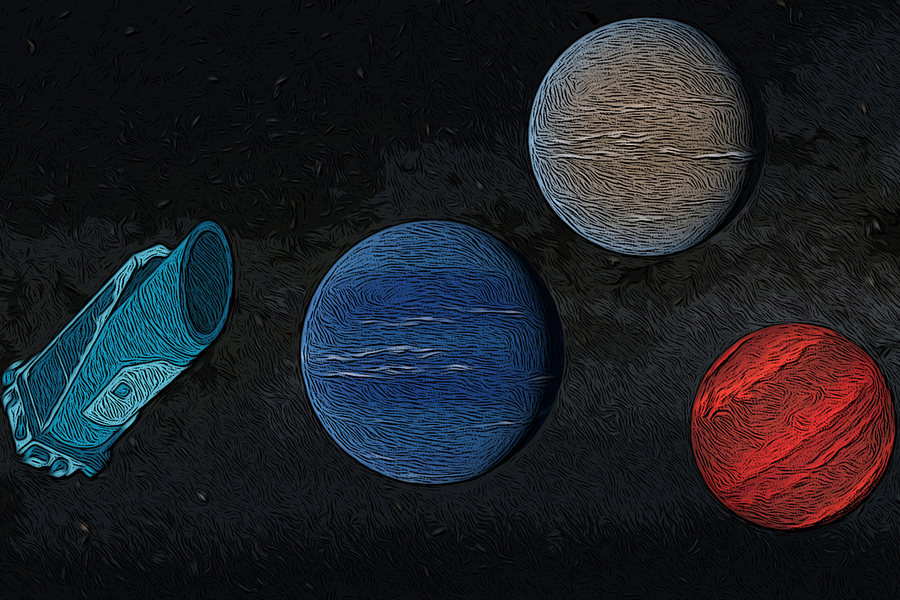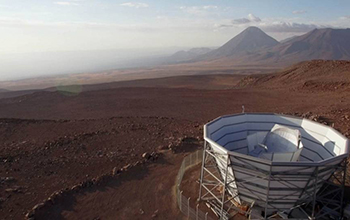搜索结果: 1-15 共查到“天文学 View”相关记录46条 . 查询时间(0.031 秒)

A telescope’s last view(图)
望远镜 开普勒望远镜 行星
2023/6/9


New view of nature's oldest light adds fresh twist to debate over universe's age(图)
New view nature oldest light adds fresh twist debate over universe's age
2020/7/31
From a mountain high in Chile's Atacama Desert, astronomers at the U.S. National Science Foundation's Atacama Cosmology Telescope (ACT) have taken a fresh look at the oldest light in th...
A Two Micron All Sky Survey view of the Sagittarius dwarf galaxy. I. Morphology of the Sagittarius core and tidal arms
the Sagittarius core tidal arms
2014/12/24
We present the first all-sky view of the Sagittarius (Sgr) dwarf galaxy mapped by M-giant star tracers detected in the complete Two Micron All Sky Survey (2MASS). Near-infrared photometry of Sgr's pro...
A Two Micron All Sky Survey view of the Sagittarius dwarf galaxy. II. Swope telescope spectroscopy of M giant stars in the dynamically cold Sagittarius tidal stream
kinematics halo
2014/12/24
We have obtained moderate resolution (~6 km s-1) spectroscopy of several hundred M giant candidates selected from Two Micron All Sky Survey photometry. Radial velocities are presented for stars mainly...
We present a 60 ks Chandra ACIS-S observation of the thermal composite supernova remnant 3C 391. The southeast-northwest elongated morphology is similar to that previously found in radio and X-ray stu...
The Chandra View of DA 530: A Subenergetic Supernova Remnant with a Pulsar Wind Nebula?
DA 530 (G93.3+6.9) ISM
2014/12/23
DA 530 (G93.3+6.9) is a high Galactic latitude supernova (SN) remnant with a well-defined shell-like radio morphology and an exceptionally low X-ray-to-radio luminosity ratio. Based on a Chandra ACIS ...
A complete view of galaxy evolution: panchromatic luminosity functions and the generation of metals
typical galaxies galaxies
2014/12/22
When and how did galaxies form and their metals accumulate? Over the last decade, this has moved from an archeological question to a live investigation: there is now a broad picture of the evolution o...
New Panoramic View of $^{12}$CO and 1.1 mm Continuum Emission in the Orion A Giant Molecular Cloud. I. Survey Overview and Possible External Triggers of Star Formation
star formation
2014/12/22
We present new, wide, and deep images in the 1.1 mm continuum and the CO ( 1–0) emission toward the northern part of the Orion A Giant Molecular Cloud (Orion-A GMC). The 1.1 mm data were taken with th...
We present new images and photometry of the massive star-forming complex Cygnus X obtained with the Infrared Array Camera (IRAC) and the Multiband Imaging Photometer for Spitzer (MIPS) on board the Sp...
THE MURMUR OF THE HIDDEN MONSTER: CHANDRA'S DECADAL VIEW OF THE SUPERMASSIVE BLACK HOLE IN M31
X-ray source flaring emission
2014/12/20
The Andromeda galaxy (M31) hosts a central supermassive black hole (SMBH), known as M31*, which is remarkable for its mass (~108 M ) and extreme radiative quiescence. Over the past decade, the Chandra...
2MASS view of the LMC: Structure, populations, kinematics
The large Magellanic cloud. 2 quality infrared photometry Magnitude diagram Stars Luminosity function
2014/12/9
The results of a study of the Large Magellanic Cloud based on near-infrared 2MASS photometry are presented. From near-infrared color-magnitude diagram, stellar populations of the LMC are identified an...

An international team of astronomers using the Atacama Large Millimeter/submillimeter Array (ALMA) and the Karl G. Jansky Very Large Array (VLA) -- among other telescopes -- has obtained the best view...
Ultra deep sub-kpc view of nearby massive compact galaxies
Gemini North telescope Ultra deep sub-kpc view massive compact galaxies
2012/2/21
Using Gemini North telescope ultra deep and high resolution (sub-kpc) K-band adaptive optics imaging of a sample of 4 nearby (z~0.15) massive (~10^{11}M_{sun}) compact (R<1.5 kpc) galaxies, we have ex...
A multifrequency view of starburst galaxies
starburst galaxies – high-energy photons –cosmic rays – molecular ions
2011/10/12
During the past few years, first observations of starburst galaxies at >GeV energies could be made with the Fermi Gamma-ray Space Telescope (GeV range) and Imaging Air Cherenkov Telescopes (TeV range)...


